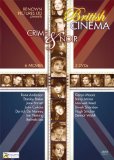| Reviews & Columns |
|
Reviews DVD TV on DVD Blu-ray 4K UHD International DVDs In Theaters Reviews by Studio Video Games Features Collector Series DVDs Easter Egg Database Interviews DVD Talk Radio Feature Articles Columns Anime Talk DVD Savant Horror DVDs The M.O.D. Squad Art House HD Talk Silent DVD
|
DVD Talk Forum |
|
|
| Resources |
|
DVD Price Search Customer Service #'s RCE Info Links |
|
Columns
|
|
|
British Cinema: Renown Pictures Crime & Noir (Blackout, Bond of Fear, Home To Danger, Meet Mr. Callaghan, No Trace, Recoil)
THE MOVIES:
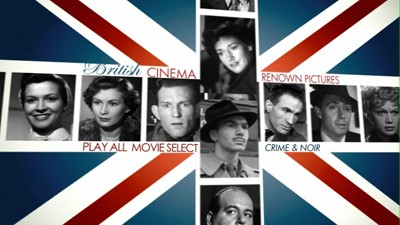
I'm going to kick my review off with a pet peeve: I absolutely hate the misuse of the term "noir" as a marketing tool. VCI's new six-movie set British Cinema: Renown Pictures Crime & Noir is a prime example of this. Just because a movie is in black-and-white and has people in raincoats shooting at other people in raincoats, it doesn't make it noir. I know this sounds ridiculous to a lot of folks reading this, but film noir fans are getting pretty fed up with being sold sets that are billed as this most favored of genres but that are really just loosely related movies dug out of the basement and given an attractive dressing-up by the ad copy department. Film noir is dark, pessimistic, and even nihilistic, not to mention stylish. Shadows, rainy streets, sharp dialogue--all aesthetic components of true noir. Granted, there are plenty of arguments about what all of that means, and quite often, fans can't agree on what noir is, but we can get together on what it is not.
What it is not is polite, ordered stories of the upper crust--which is largely what we get in British Cinema: Renown Pictures Crime & Noir. These six movies, released between 1950 and 1956, are crime pictures, but they are largely tame and overly nice, and when they do stray from their portrayals of very British exasperated criminals and accidental, stiff-upper-lip heroes, it's to try to outfit those same characters in American clothes. Derrick De Marney's portrayal of the private investigator Slim Callaghan in Meet Mr. Callaghan, for instance, tries to remodel the English actor as a Humphrey Bogart or maybe Dick Powell type. They'd have done better going for Steve Martin in Dead Men Don't Wear Plaid.
I had assumed that Renown Pictures was a studio from the period, but it turns out that they are a modern distribution company that, among other endeavors, has resurrected a large library of older British films, including various sets that have been released in the states through VCI. My hat is off to them for that. The more cinema lovers getting into preserving old films, the better. Even so, my hat goes back on, and I must assess this set honestly. Spread over two DVDs, with three films crammed on each, both the package and the content here leaves a little to be desired. For one, the back cover and the discs are mislabeled as to what films are on each. Meet Mr. Callaghan is on DVD 1, while Bond of Fear is on DVD 2. There are also multiple misspellings of names. It's a half-hearted attention to detail on behalf of half-hearted films. Most of these are tepid, bottom-of-the bill C-listers rather than sorely neglected B-listers. Even with short running times (Home to Danger is 66 minutes, while Callaghan is longest at 88), the stiff, predictable delivery can make these flicks a bit of a chore to get through.
*** DVD 1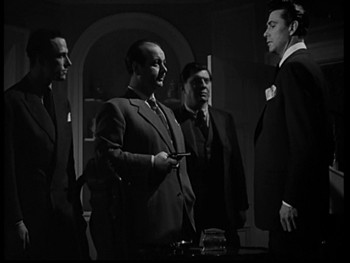
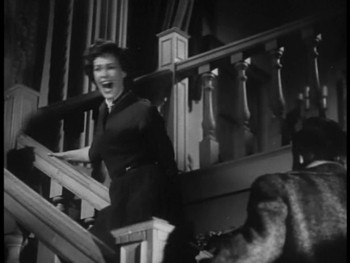
left to right: Blackout; Home to Danger
Blackout (1950; 73 minutes): The lead film in the set is blessed with a great concept, but alas, mostly squanders it. Maxwell Reed (Sea Devils) stars as Christopher, a man who has recently been blinded and is about to have surgery to correct the problem. On his way to the operating table, he stumbles into a murder in progress, and though he can't see who did it, he never forgets a voice. Once his sight is back, he sets out to find out what happened. The police have no record of the crime, but some basic detective work leads Christopher back to the house where the killing would have happened, and he becomes involved with the dead man's sister (Dinah Sheridan). Directed by Robert S. Baker, who went on to produce "The Saint" on television, Blackout has all the right story points but seemingly no idea what to do in between those points or how to even make those good spots actually exciting. Reed is a wooden performer, and the role only requires him to keep moving forward. Momentum carries him through the story rather than any real shades of character. The villains display some menace in the first scene, but are quickly neutralized as believable threats. This is very basic, no-budget stuff, efficient but lacking in all things that might distinguish it.
Home to Danger (1951; 66 minutes): Directed by Hammer mainstay Terence Fisher, Home to Danger is another film with an interesting set-up, playing on the class dichotomy between the lush countryside estates of the well-to-do and the dismal city streets plagued with poverty. Rona Anderson (Scrooge) is Barbara, the estranged daughter of a businessman who has returned to England from America upon the old man's death. Turns out daddy forgave her and left her his fortune and the family business, a development that doesn't make everyone happy. Unbeknownst to the dearly departed, his company was being used for drug trafficking, and Barbara and her new beau (Guy Rolfe, Ivanhoe) must figure out who is behind it before Barbara ends up dead.
What is most memorable about Home to Danger are the dark depictions of the criminal underworld. Barbara and her man visit the shadowy streets of the slums, deal with junkies, and basically see everything that wealth and privilege protects them from. The script stops short of making much out of these elements, however, and though there are a couple of heavy scenes involving drugs, they are undercut by censorship and euphemism. The love story seems more important to Fisher and his cadre of writers, and it's not very original. Home to Danger never comes to boil.
Meet Mr. Callaghan (1954; 88 minutes): Though Peter Cheyney's Slim Callaghan would apparently go on to have further adventures on television and film in France, the series was a non-starter in England. Based on this film, helmed by Charles Saunders and written by Brock Williams (also responsible for some of the story in Michael Powell's Contraband), that's really no surprise. Meet Mr. Callaghan is your basic private eye tale: a dame (Harriette Johns, A Night to Remember) goes to the detective's office and feeds him a likely story, but upon further investigation, he discovers she's caught up in a larger criminal racket. Her visit coincides with the murder of one of her gangster fiancé's relatives, and Callaghan has to prove who really did the deed before an adversarial police inspector (Trevor Reid, who also appears in Bond of Fear elsewhere in the set) stitches him up for the whole thing.
There was a recent Saturday Night Live sketch about a Norwegian theatre troupe trying to stage their own version of an American police show. It's pretty funny, with the humor of course coming out of the schism between the two cultures and what is lost in translation. The foreign performers only understand the surface of the story, their broken English seizes on the strange jargon, and it's funny to see the square peg trying to fit in the round donut hole. I felt much of the same was happening when watching Meet Mr. Callaghan. The filmmakers try to make Slim Callaghan into a British Sam Spade, but Derrick De Marney's stilted portrayal never quite works. He is not a very forceful performer. To be fair, though, his world doesn't really require him to be. This is the type of crime movie where everyone sits around and talks rather than throwing a punch or drawing a gun. You can tell they really want to break out the tea set and sit down like civilized Englishmen, but they are afraid it would destroy the fragile illusion. The end result is that Callaghan looks like a crazy person who has seen too many Bogart movies, and everyone is going along with him rather than exacerbate his condition.
*** DVD 2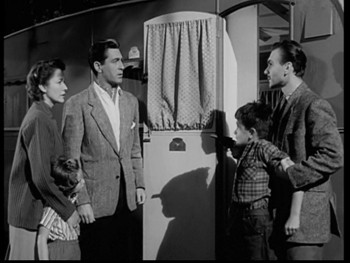
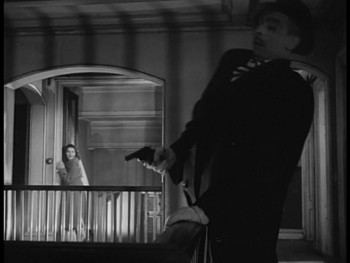
Bond of Fear; Recoil
Bond of Fear (1956; 72 minutes): A soldier and family man, John Sewell (Dermot Walsh, The Flesh and the Fiends), and his vacationing clan unwittingly provide a fleeing killer with his escape when the bad man (John Colicos) hides in their camper. He ends up taking their young son (Anthony Pavey) hostage while John and his wife (Jane Barrett) and daughter (Marilyn Baker) ride up front. The situation generates some natural tension, though much of that is spent on an overlong sequence involving trying to get out of a ruse where John tells a police officer that his son is sick. Daddy is trying to keep his cool and approach the situation intellectually, so the best scenes come when the other family members try their own ploys--the boy making a run for it or a play for the killer's gun, or the mother trying to bargain, her life for her child's.
Henry Cass, who directed the Alec Guinness film Last Holiday, was behind the camera for Bond of Fear, and he has a straight-ahead, no-nonsense style that works both for and against material of this kind. When efficiency is required, Cass is your man; other times, he needs to indulge and draw things out a bit more. Specifically, the climax is a letdown. It's barely a fight, just three punches and that's that.
No Trace (1950; 75 minutes): John Gilling is all over this DVD. He wrote both of the other films on this disc, as well as directing Recoil; oddly, No Trace, though directed by him, is not written by him. The script is by Robert S. Baker, who directed Blackout and produced many of these movies.
No Trace is not just the name of the movie, but the name of a book written by crime writer Robert Southley (Hugh Sinclair, who played the Saint in the 1940s movies featuring the character). Robert's success isn't due to an active imagination, though, he's taken the "write what you know" axiom far too literally. The book is based on his real experience, and when one of his old accomplices (Michael Brennan) shows up to blackmail him, murder ends up being a more effective currency than British pounds. The real twist comes, however, when Robert helps the police investigate the case, effectively searching for himself. Existential much? Adding to the man's anxiety, his secretary (Dinah Sheridan again) invents a story line for him much like what is really happening.
Gilling clearly watched some American film noir, or at least Hitchcock. He isn't afraid of low, tight angles, giving the murder scene a manicured chill. Hugh Sinclair is actually quite good as the unblinking, calculated criminal. His indifference to human life makes him a distant cousin to a true noir villain. It's not enough to really save the film, though. Sheridan's amateur sleuthing gets a little cute, more light Agatha Christie territory than dark Shadow of a Doubt territory. Not a bad film as much as it is merely diverting.
Recoil (1953; 79 minutes): Amateur sleuthing by a girl also comes up in this Gilling-helmed picture. Elizabeth Sellars (The Barefoot Contessa) plays Jean Talbot, the daughter of a jeweler who is robbed and killed by a trio of hoodlums. The crooks flee the scene and crash their car, killing all but one. The survivor, Michael (Edward Underdown, Beat the Devil), goes to his doctor brother, Nicholas (Kieron Moore, Arabesque), to fix up his wounds. This implicates the good brother despite his innocence. Jean gets in between the two men when the cops can't get to them, playing a dangerous game of seduction. Think Notorious without the romance or the nerves. The movie starts out well enough with a rather good crime set up, but like No Trace, it loses its way when the full focus falls on the lady snooper. Sellars is alluring and has her moments of coy charm, but Underdown is a bit of a lunkhead, all square jaw and deep voice, like a precursor to James Caan but lacking in the fiery anger. The third act of the picture shows Jean playing Bonnie to Michael's Clyde, and it's pretty ludicrous even by backlot crime picture standards. And it's not the fun kind of ludicrous either.
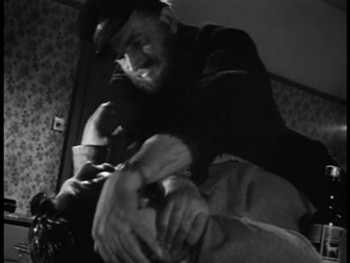
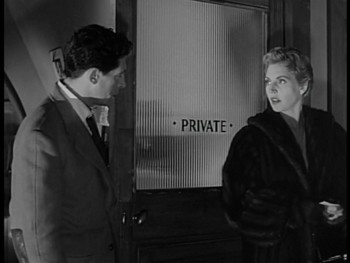
No Trace; Meet Mr. Callaghan
THE DVD
Video:
As noted above, British Cinema: Renown Pictures Crime & Noir has crammed three movies onto two discs. All of the films are in black-and-white, presented in full frame (1.33:1). The images are fairly average for old prints. They haven't been restored much, if at all, and so tend to have scratches, spots, and the lot. The basic image is clear under the grime, however, and none of them are so beat up as to be offensive or unwatchable. The digital resolution is decent, though there are no great values between the dark and the lights; just as the metaphorical shadows in this film aren't very dark, neither are the literal ones. There films also display the telltale jagged edges of interlacing.
Both discs have a "play all" function, and you can also pick which movie you want and each movie has a submenu with scene selection. Regardless of where you start, however, "play all" is always in effect and one movie will start immediately after the previous one ends.
Sound:
The English-language soundtracks are given a mono mix in Dolby Digital. Like the image, these can be a little beat up, with some hiss and the occasional snap, crack, or pop. The dialogue is generally clear. Though these are produced somewhat on the cheap, they are at least equal to some of the lower-shelf releases of older films from major studios and better than, say, public domain discs.
The exception in both cases is No Trace, which looks and sounds a little like you are viewing the movie from inside an aquarium. Both the audio and video are distant and hazy, with soft tones and soft lines. The second worst is Home to Danger, but it is somewhat better than Trace.
Extras:
The British Cinema: Renown Pictures Crime & Noir collection comes in a standard-sized plastic case with a hinged interior tray to make room for the second disc.
The only bonus materials are trailers--though not for the movies in the set (and not counting the annoying VCI promo that plays when the discs are inserted and that I can never make it all the way through). They don't even relate to the set's theme. On DVD 1, the trailer is for the teensploitation Dragstrip Girl and Girls in Prison and the melodrama No Orchids for Miss Blandish; on DVD 2, a pretty cool looking crime film with the awesome title Paper Gallows (stars Dermot Walsh and Rona Anderson, who feature in movies in this set), The Third Man surprisingly enough, and another exploitation picture, Motorcycle Men.
FINAL THOUGHTS:
British Cinema: Renown Pictures Crime & Noir is a lower-tier package of lower-tier British films from the 1950s. Clichéd crime plots falter without the cynical writing or pleasing aesthetic of true film noir, and the almost comical politeness of most of the bad boys and dangerous dames defangs any sex and violence that might come along. If this were a rental situation, the second disc of the set might be worth a look, but just barely, and disc one can be foregone entirely. So, the smart bet is to Skip It all the way.
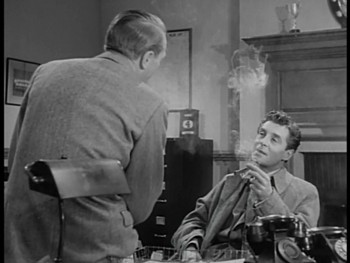
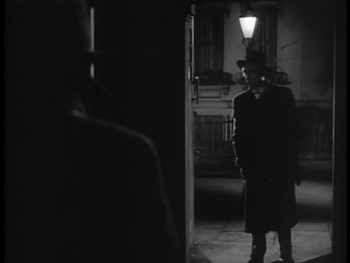
Meet Mr. Callaghan; Home to Danger
Jamie S. Rich is a novelist and comic book writer. He is best known for his collaborations with Joelle Jones, including the hardboiled crime comic book You Have Killed Me, the challenging romance 12 Reasons Why I Love Her, and the 2007 prose novel Have You Seen the Horizon Lately?, for which Jones did the cover. All three were published by Oni Press. His most recent projects include the futuristic romance A Boy and a Girl with Natalie Nourigat; Archer Coe and the Thousand Natural Shocks, a loopy crime tale drawn by Dan Christensen; and the horror miniseries Madame Frankenstein, a collaboration with Megan Levens. Follow Rich's blog at Confessions123.com.
|
| Popular Reviews |
| Sponsored Links |
|
|
| Sponsored Links |
|
|
| Release List | Reviews | Shop | Newsletter | Forum | DVD Giveaways | Blu-Ray | Advertise |
|
Copyright 2024 DVDTalk.com All Rights Reserved. Legal Info, Privacy Policy, Terms of Use,
Manage Preferences,
Your Privacy Choices | |||||||









